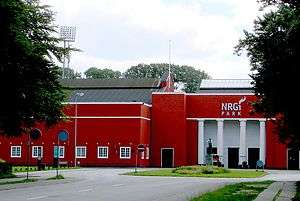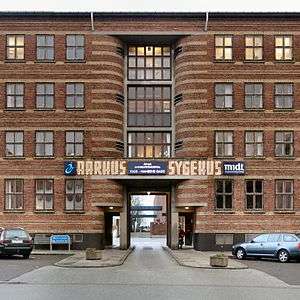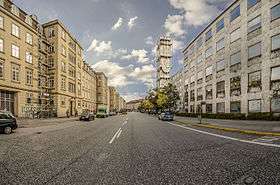Axel Høeg-Hansen
| Axel Høeg-Hansen | |
|---|---|
 | |
| Born |
27 June 1877 Sorø, Denmark |
| Died |
30 August 1947 (aged 70) Aarhus, Denmark |
| Nationality | Danish |
| Alma mater | Royal Danish Academy of Fine Arts |
| Occupation | Architect |
| Buildings |
Kunsthal Aarhus (1917) Atletion 1920 |
| Projects | Park Allé |
Axel Høeg-Hansen was a Danish architect who primarily worked in and around Aarhus at the turn of the 20th century. Høeg-Hansen built many notable structures in Aarhus and left his mark across the city. He designed Kunsthal Aarhus (1917), Atletion (1920), the yellow city blocks in Park Allé and at Banegårdspladsen (1920s), Aarhus County Hospital (1935) and neighborhoods in the southern part of the city. Stylistically he mainly worked in functionalist and neoclassical styles.[1][2]
Axel Høeg-Hansen was born 1877 on Frederiksberg. He attended vocational school for business in 1893-94 and went on to become a master mason in 1897. He attended vocational technical school from which he graduated in 1898 and was then admitted to the architect school of the Royal Danish Academy of Fine Arts where he studied between 1898 and 1907 and graduated with a degree in architecture.[3]
Høeg-Hansen worked for Ulrik Plesner in 1898; Claudius August Wiinholt between 1898-99; Fritz Koch between 1900 and 1905 and Anton Rosen between 1907 and 1909. He had his own architects company in Aarhus from 1909 and held an exhibition on the Charlottenborg Spring Exhibition the same year. From 1935 to 1940 his company was jointly run with Harald Salling-Mortensen.[2][3]
Høeg-Hansen received K.A. Larssens Grant 1905-06, bronze medal at the Danish National Exhibition of 1909, the silver medal in 1920 for Atletion and received the Architects' Association of Denmarks honorary medal in 1939. He represented Denmark in the discipline architecture at the 1928 Summer Olympics in Amsterdam. Høeg-Hansen became knight of the Order of the Dannebrog in 1924 and received the Order of the Dannebrog in 1935. He was a member of the board of Architects' Association of Denmark from 1909 to 1919 and chairman of the department of Jutland from 1933 to 1938.[2]
He was married on 23 June 1909 in Helgenæs to lnga Pauline Liggern Hansen, died on 30 August 1947 at Frederiksværk and is buried on Solbjerg Parkkirkegård in Frederiksbjerg.[2]
Selected works
- Regina, Søndergade 53 (1918)
- Slippen (1918) Port of Aarhus administrative building
- Atletion (1916–18)
- Aarhus County Hospital (1931, with Harald Salling-Mortensen)
- Roskilde County Hospital (1937–40, with Harald Salling-Mortensen and Hans Schmidt)
- Administrative building for Frichs in Åbyhøj
Gallery
-

Regina building
-

Atletion stadium
-

Aarhus County Hospital main entrance
-

Park Allé
-
Kunsthal Aarhus
References
- ↑ "Aarhus - arkitektur og museer" (in Danish). Gyldendal's enclyclopedia Den Store Danske. Archived from the original on 2016-02-18. Retrieved 18 February 2016.
- 1 2 3 4 "Axel Johannes Høeg-Hansen" (in Danish). Danish Ministry of Culture. Archived from the original on 18 February 2016. Retrieved 18 February 2016.
- 1 2 "Axel Høeg-Hansen" (in Danish). Aarhus City Archives. Archived from the original on 2016-02-18. Retrieved 18 February 2016.